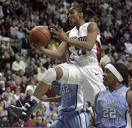
Recently, I was watching highlights of a women's NCAA tournament game at the gym. I was excited to see the strength and athleticism of these girls. I started to think about how these girls are stronger and more athletic than the girls that played even just ten years before them. Then, I looked around the gym and noticed that the average member is in worse physical condition than ever. The differences between these two groups is astonishing. And, it is not just body fatness, it was evident in how they moved (or attempted to move).
The performance dichotomy is of interest to me for two reasons. One, the athletes training techniques (especially strength training for women) has improved over the last decade. Two, the average adult is in worse shape than ever. It is alarming. It also changes how I train adults.
In the past, adults could simply start exercising. They could take up running, start lifting weights and would be on their way to better fitness. Now, you have to contend with stiff and unstable joints, horrible posture, chronic illnesses, severe obesity, and weakness. And these people are only in their 30's!
These new physical deficits have to be addressed before you can pursue your ultimate fitness and performance goals. If you don't, you will very quickly see that your body can't handle the training stresses. This can be a little frustrating for people who want to see quick results. But, ultimately you will be able to continue to train without being sidelined when you address these deficits.
Of course, so many people will never understand that they are not only obese, but their body functions extremely poorly. But, because of shows like "The Biggest Loser" and the rising popularity of boot camp workouts they will jump into challenging workouts. "The Biggest Loser" shows extremely overweight individuals performing exercise like plyometrics and high-intensity strength training, with horrible technique, just to burn some Calories. I cringe when I watch these shows. Mike Robertson, who I look to for advice sometimes says "getting stronger is easy, it is staying healthy and not getting hurt is the hard part." More true than ever.


2 comments:
This is SO true! I remember when I first started training with you, I was frustrated. Not only did I want quick results, but I felt like I wasn't DOING anything. I had worked out regularly prior to you, so I felt like I was going backwards initially.
Now, a year later, I get it! (It didn't really take me that long, but you get my point). I did high-intensity strength training in the past, and inevitably, I would end up hurt--typicaly my back or knees. Then I would have to take time off training---often for six weeks and popping anti-inflammatories the whole time. I have not had one single training related injury/pain in the past year. In fact, when an ache or a pain has cropped up, I have learned to increase my training with you to make it go away!
Julie,
You are not alone. A lot of people end up hurting themselves; their bodies are just not able to handle all of the stresses. Unfortunately, a lot of personal trainers and coaches don't understand this. They feel that the client simply needs to be pushed harder, without considering a clients technique, flexibility, stability, or tolerance. Again, training should stimulate the body to improve, not annihilate it!
Post a Comment